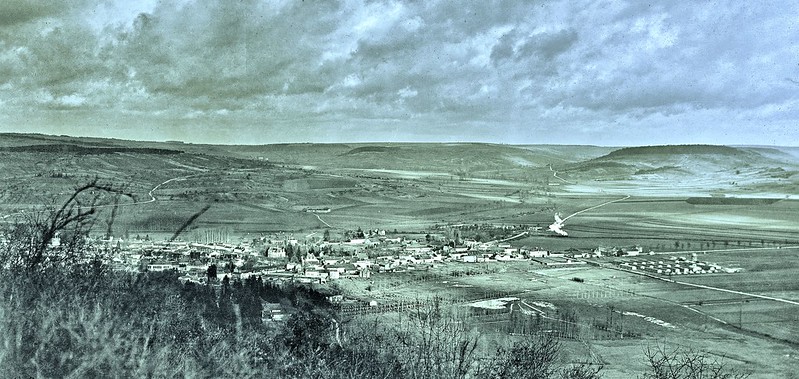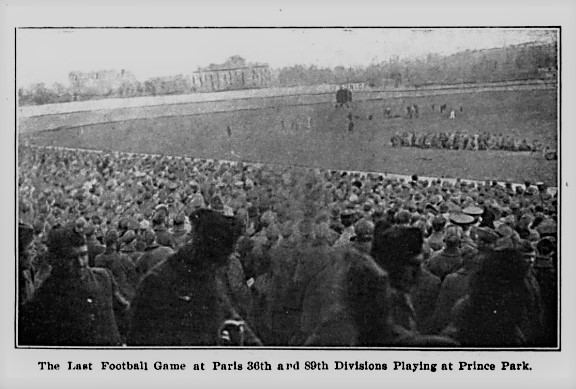
Although the first Super Bowl was played in January 1967, sports historians consider the 1919 AEF Football Championship as rightfully the first national championship game. And it was played in Paris!
American Expeditionary Forces commander John J. Pershing was facing a morale problem at the end of 1918. Germany had signed an Armistice, which had stopped the fighting. But the war was not over. Between the November 11, 1918 Armistice and a formal peace treaty was months of diplomatic back-and-forth between the Allies and Germany. Mostly, it was a back-and-forth among the Allies over which victorious nation would receive what concessions from the defeated nations.

As the peace process went on and the cease-fire was extended month after month, General Pershing knew he had to keep the Americans in Europe busy. What he and his staff envisioned was a schedule of sports and military competitions to keep the men engaged and healthy. The Federal Government pledged one million dollars to a program of recreation and sports for Americans serving in Europe.
The Government’s million-dollar bet paid off. The citizen soldiers of the AEF were better accustomed to sports than military pursuits. When war made such sacrifices necessary, American men made them. Now the fighting was over, their interest in military matters waned. Soldiers and Marines enthusiastically switched gears and took up athletics. In the 36th Division, there were fifty-two football teams spread across the 16th Training Area.

Panthers football
The first AEF football season revealed the 36th Infantry Division All-Star team hard to beat. They won every game but the unofficial championships versus Services of Supply-Saint Nazaire. A second, longer season immediately got underway. Captain Wilmot Whitney, who’d played while a student at Harvard, coached the team. In addition Capt. Whitney was also on the field as quarterback. Captain Walter Birge, formerly of the University of Texas Longhorns, was another coach in the 36th All Stars. This wealth of gridiron talent was common throughout teams in the AEF in 1919.
In the second season, the 36th Division beat its neighbors in the Sixteenth Training Area, the 78th and 80th Divisions to win I Corps. They then defeated the First Army Headquarters team, 3-0. It took the 36th two games to beat the 29th Division (the first game was tied, 0-0). The First Army Championship game was played on March 1 in Bar-sur-Aube in the 13th Training Area, previously the home of the 36th Division. In the rematch with the 29th Infantry, the Panthers won 3-0 to claim First Army.

Road to Victory
Fresh off their victory for the First Army crown, the 36th eleven found themselves in the AEF playoffs. At the quarterfinals, they faced S.O.S.-Le Mans at the Auteuil Velodrome, where the 36th Division won 13-0. On March 21, 1919, the semi-finals pitched the 36th Division against the Second Army champs, the 7th Infantry Division. A mass of 25,000 soldiers gathered at Bar-sur-Aube to view the semi-finals, overwhelming the town of four thousand. King Albert and Queen Elizabeth of Belgium were there. General Pershing was there, and of course the generals commanding First Army and Second Army.
The March weather was raw and drizzly. The two teams duked it out in the mud, taking penalties and picking up fumbles. The game went into the fourth quarter with no score. A late play in 7th Division territory yielded the lone touchdown for the 36th, who kicked for the extra point. The huge crowd, including eight thousand Arrowheads, rushed the field in celebration. Also joining the two teams on the muddy field were their Royal Highnesses, who paused to have their picture taken with the gladiators in green. Crowned heads were treated to a little American cheek while waiting for the photographer to take the picture: a voice called out from the enlisted throng, “Hurry up, kid, it’s cold out here.” Another called out, “I want to go home.” An icy stare from their Commander-in-Chief, Pershing, brought the crowd to order.

The Game
Parc des Princes, a velodrome in Paris, was the site of the first superbowl. Opposing the 36th was the 89th Division, Third Army champions with a perfect record. Nearly four thousand Arrowheads arrived in Paris on March 29, 1919 on leave, and a few thousand without leave, for the game. Generals, a Navy admiral, politicians, and a surprising number of French citizens were also present. In addition, twelve hundred soldiers from the 89th arrived by special train from Germany, where the division was stationed.
Once again in the cold and mud, the titans of the AEF battled for the championship. The 36th Division team dominated in the first half, exploiting a fumble and scoring in the first quarter. Arrowheads in the crowd went wild with an on-field celebration. In the second half, the 89th regained their composure and scored two touchdowns. The Third Army champs won the AEF, 14-6. In conclusion, General Pershing told the two teams, “You have carried out the letter and the spirit of the plan adopted to promote clean sports.”

Is the first (top) picture the 36th Division Team? My Grandfather is Cpt Whitney. I have a challenge or commemorative coin from 1919 with his name on it from the game with the 89th Div. My mother gave to me.
Eric, thanks for writing.
The first photo is not identified further than being one of the AEF Divisional teams in 1919. There is a great article about “The Game” which I used for this post: https://www.theworldwar.org/sites/default/files/2022-01/wwi-kansas-history-football.pdf
That is awesome that you have a souvenir of that event. It was perhaps the highlight of the 36th’s six-month wait to go home.